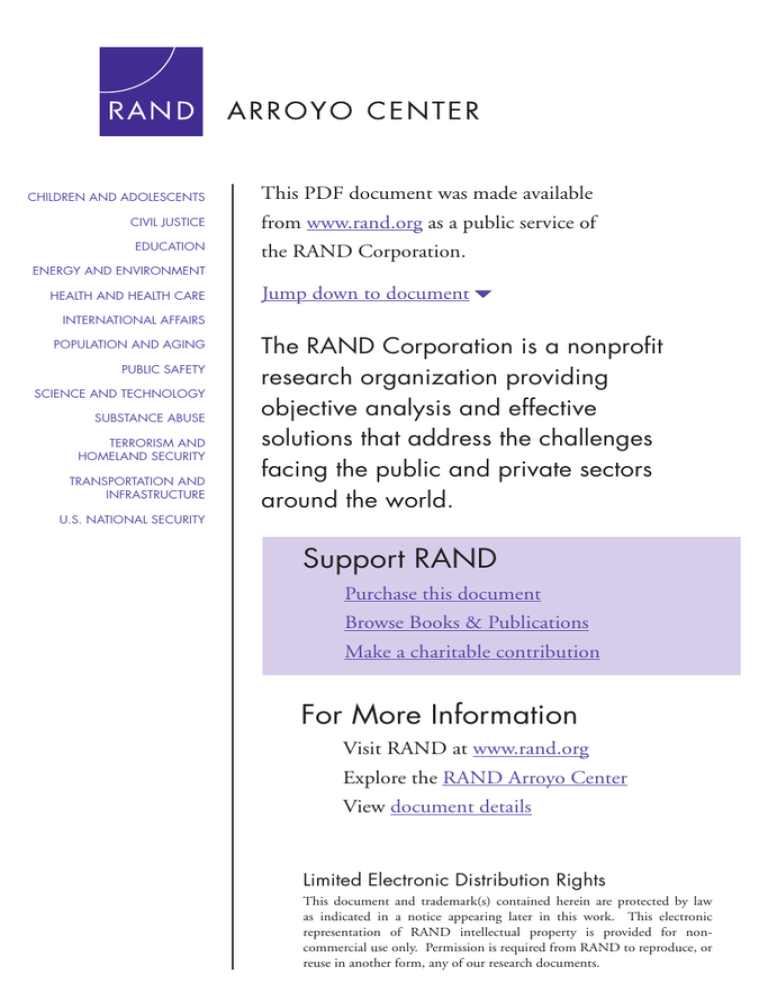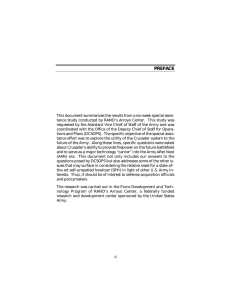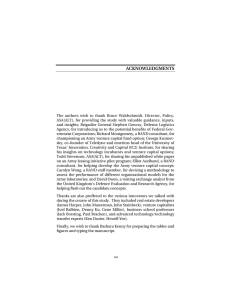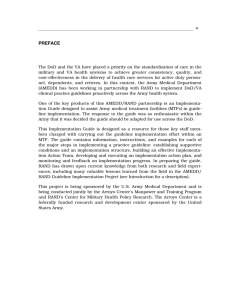
CHILDREN AND ADOLESCENTS
This PDF document was made available
CIVIL JUSTICE
from www.rand.org as a public service of
EDUCATION
the RAND Corporation.
ENERGY AND ENVIRONMENT
HEALTH AND HEALTH CARE
Jump down to document6
INTERNATIONAL AFFAIRS
POPULATION AND AGING
PUBLIC SAFETY
SCIENCE AND TECHNOLOGY
SUBSTANCE ABUSE
TERRORISM AND
HOMELAND SECURITY
TRANSPORTATION AND
INFRASTRUCTURE
U.S. NATIONAL SECURITY
The RAND Corporation is a nonprofit
research organization providing
objective analysis and effective
solutions that address the challenges
facing the public and private sectors
around the world.
Support RAND
Purchase this document
Browse Books & Publications
Make a charitable contribution
For More Information
Visit RAND at www.rand.org
Explore the RAND Arroyo Center
View document details
Limited Electronic Distribution Rights
This document and trademark(s) contained herein are protected by law
as indicated in a notice appearing later in this work. This electronic
representation of RAND intellectual property is provided for noncommercial use only. Permission is required from RAND to reproduce, or
reuse in another form, any of our research documents.
This product is part of the RAND Corporation monograph series.
RAND monographs present major research findings that address the
challenges facing the public and private sectors. All RAND monographs undergo rigorous peer review to ensure high standards for
research quality and objectivity.
Future Army
Bandwidth Needs
and Capabilities
LELAND JOE
ISAAC PORCHE III
Prepared for the United States Army
Approved for public release, distribution unlimited
The research described in this report was sponsored by the United States
Army under Contract No. DASW01-01-C-0003.
Library of Congress Cataloging-in-Publication Data
Joe, Leland.
Future army bandwidth needs and capabilities / Leland Joe, Issac Porche III.
p. cm.
Includes bibliographical references.
“MG-156.”
ISBN 0-8330-3545-2 (pbk.)
1. United States. Army–Communication systems. 2. Broadband communication
systems—United States. I. Porche, Isaac, 1968– II.Title.
UG593.J64 2004
355.2'7—dc22
2004009651
The RAND Corporation is a nonprofit research organization providing
objective analysis and effective solutions that address the challenges
facing the public and private sectors around the world. RAND’s
publications do not necessarily reflect the opinions of its research clients
and sponsors.
R® is a registered trademark.
© Copyright 2004 RAND Corporation
All rights reserved. No part of this book may be reproduced in any form
by any electronic or mechanical means (including photocopying,
recording, or information storage and retrieval) without permission in
writing from RAND.
Published 2004 by the RAND Corporation
1700 Main Street, P.O. Box 2138, Santa Monica, CA 90407-2138
1200 South Hayes Street, Arlington, VA 22202-5050
201 North Craig Street, Suite 202, Pittsburgh, PA 15213-1516
RAND URL: http://www.rand.org/
To order RAND documents or to obtain additional information, contact
Distribution Services: Telephone: (310) 451-7002;
Fax: (310) 451-6915; Email: order@rand.org
Summary
Across the services, there is an increasing demand for communications capacity. For the U.S. Army, this is a result of the Army’s transition to a new force structure that will be knowledge-based1 and
network-centric.2 Since bandwidth facilitates communications capacity, bandwidth has become increasingly critical. To the user, high
bandwidth is useful because it supports increased capacity, highvolume data exchange, short delays, and high assurance of connectivity. New technologies, commercial and military, will continue to
increase available bandwidth and hence the communications capacity
available to users. Based on specified requirements and proposed
technologies and architectures for the future force, the capacity of
communications systems planned to support the new force structure
will continue to fall short of the required demand.
With unlimited spectrum and unlimited budget, the Army
could resolve its bandwidth issues. But these are unrealistic assumptions. Certainly, demand reduction can help close the gap between
the requirements and availability of network capacity. However, it is
not clear how much demand reduction is possible while retaining the
information dominance that is critical for the future force. Demand
reduction will need to be coupled with technology investments (e.g.,
satellites, UAVs, directional antennas, more radios). A number of
____________
1
Casper et al. (1996).
2
Cebrowski and Garstka (1998).
xv
xvi
Future Army Bandwidth Needs and Capabilities
technologies and concepts are being developed to enhance spectral
efficiency, thus allowing the Army to make the best use of the available spectrum. Gaps between the supply and demand of capacity,
both now and in the future, will have to be addressed by constantly
reassessing demand for capacity and developing technologies that increase the supply.
It is important to note that bandwidth is not the only issue with
regard to networked communication. Among the other critical issues
are communications-on-the-move (not widely possible in Operation
Iraqi Freedom) and interoperability. The Joint Tactical Radio System
will be required to address these two issues.
Although the Army can take advantage of commercially developed technologies, the Army’s operational situation differs fundamentally from that of industry. Currently, the Army differs from
commercial industry in its approach to user and communications infrastructure mobility, information assurance (i.e., secure communication), and interoperability. It is not clear that the commercial world
will be the source of all of the technology solutions. Department of
Defense (DoD) funded initiatives are likely to be critical to the development of the key technologies.
Recent RAND Arroyo Center research analyzed how the Army
uses bandwidth. As a result, this report describes a number of specific
steps that can be taken to address the gap. They are listed below in
order of priority, where priority is assigned to the steps that are likely
to lead to the largest gains, based on our assessment.
Reassess Information Demands and Needs
The Army must perform experiments to understand what drives
“real-world” information demands. There exists only a scant amount
of data on the details of real-world demands and there has been little
analysis of the necessity and the value of proposed information flows
at each of the various echelons. Furthermore, the Army must reassess
the necessity of these information requests. More experimentation is
Summary
xvii
needed to test how various information demands contribute to mission success.
Change Application Structure
Applications determine the volume and timing of a large part of information flow. Adjusting applications demands, such as by compression, can decrease bandwidth requirements by orders of magnitude.
Minimizing the need to transmit raw sensor data will be beneficial,
especially if local fusion is feasible. However, explicit performance
assessments must be conducted to maintain quality with respect to
data fusion and compression.
Manage Operational Demands to Meet Needs
Information traffic patterns exhibit differing needs for different priority users. Changing information needs require a dynamic network
management approach to prioritize and smooth flow through the
network. This has already been explicitly recommended in an Operation Iraqi Freedom after action report.3
Increase Efficiency of Network Routing
Army communications are increasingly network based and must be
addressed from a network perspective. The Army CommunicationsElectronics Command (CECOM), the Defense Advanced Research
Projects Agency (DARPA), and commercial industry are attempting
to increase capacity through more efficient routing through networks.
____________
3 Shaaber, Hedberg, and Wesson (2003) call for the “ability to manage bandwidth usage
dynamically at the discretion of the commander [to allocate bandwidth] commensurate with
operational priorities.”
xviii
Future Army Bandwidth Needs and Capabilities
These techniques take advantage of knowledge of the network state to
improve routing efficiency.
Increase Capacities of Links
Both CECOM and DARPA (e.g., in their FCS Communications and
Next-Generation Communications programs) are working to increase
link capacities by using higher frequencies and directional antennas.
Theoretical assessments by Yi, Pei, and Kalyanaraman (2003) show
that the capacity-multiplying effect of directional antennas over today’s nondirectional (omnidirectional) antennas could be as high as
one to two orders of magnitude, depending on the technology used.
These are better results than what has been seen in simulation of
various types of directional systems. Clearly, the opportunity for improvement exists, and more development is needed to fully realize the
benefits of this concept. If directional antenna systems can be developed to their full potential, they could help ameliorate the inherent
capacity limitations of large numbers of radios sharing a frequency
channel.
Today’s fixed, limited frequency allocation of available spectrum
creates a hard limit on the amount of capacity, especially for ground
vehicles on the move. Commercial demands in the United States,
Europe, and elsewhere are squeezing the available spectrum for use by
the U.S. military and its allies.4 By one estimate, there may be as little
as 55 MHz available5 today for the Army; this could translate into 50
to 100 Mbps capacity for a given area of operation, at best. (Such
____________
4
Quoting: “high-tech companies are lobbying to block the recent DOD proposal [to open
up the 5,150 to 5,720] megahertz band to accommodate the burgeoning industry.” Inside the
Pentagon, “DoD Battles Industry on Spectrum Wanted for Wireless Networking,” December
2002.
5 This is when given only the JTRS threshold operating frequencies, which are between 2
Mhz and 2 Ghz, when considering availability for the Future Combat Systems (FCS) communication network. U.S. Army, “FCS WNW Spectrum Requirement” white paper, December 6, 2002.
Summary
xix
limited spectrum access in CONUS also prohibits the “train as you
fight” notion.) The lower end of this range may not be sufficient to
accommodate one brigade-sized unit’s situational awareness needs.6
Spectral reuse is key to achieving as much capacity as possible.
Directional antennas facilitate reuse even with fixed frequency/spectral allocations. Fully dynamic spectrum management
could facilitate even greater reuse of the spectrum by obviating the
need for static channel/frequency assignments. DARPA is developing
technologies to enable dynamic access to radio frequency spectrum.
This is an important technology concept that needs to continue development.
Overall Assessment and Recommendations
Bandwidth is a limited resource that needs to be managed. New
technologies will greatly increase capacity, but unchecked user demands will probably keep pace and exceed available capacities. No
single technique will solve the problem. There are no silver bullets.
The challenge is to meet the right users’ needs at the right time.
To achieve this, it is recommended the Army do the following. First,
bandwidth needs to be treated as an operational resource to be allocated by commanders and staffs. Second, the Army should continue
to pursue all technologies that could provide benefit. Technology development should be synchronized through a single cognizant agency
for efficiency and coordination. This includes not only communications systems but also systems-of-systems to reduce demands and create an overall information architecture. Third, the Army should develop and refine assessment tools; better assessment tools are needed
to make complex tradeoffs. Last, the Army needs to make a partner of
DoD to avoid unnecessary redirection and to take advantage of DoDwide capabilities. This is especially important with respect to the
____________
6 Assuming an average situational awareness (SA) data rate of 64 kilobits per second per
vehicle/node and a 1,000+ node brigade.
xx
Future Army Bandwidth Needs and Capabilities
DoD efforts to maintain and perhaps acquire new spectral allocations.





